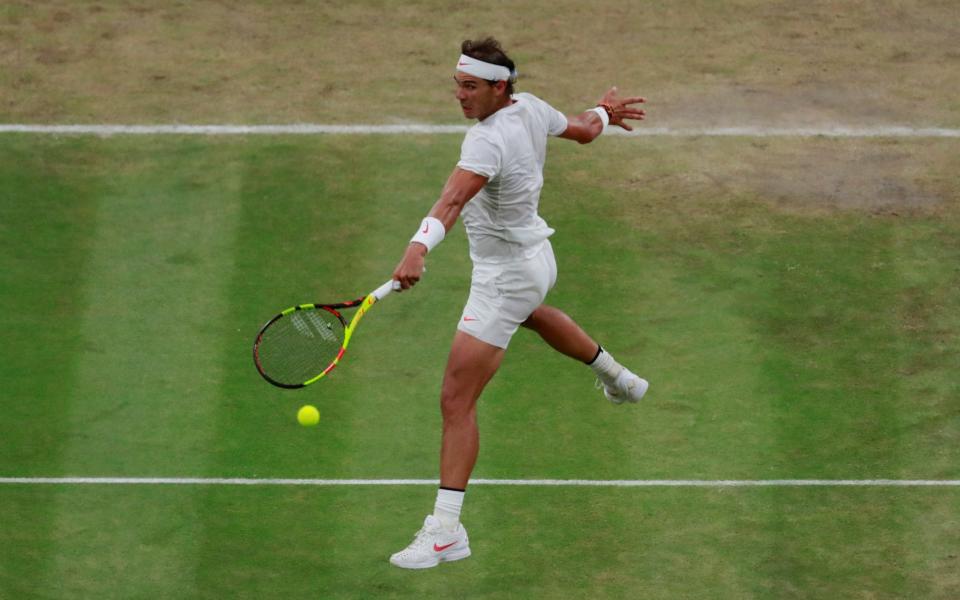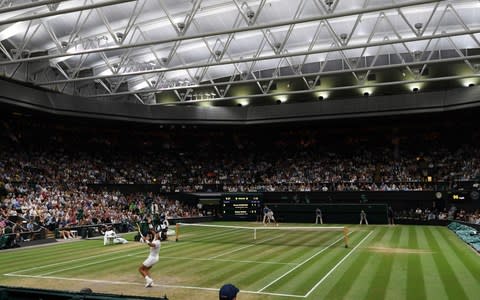Rafael Nadal brings out Novak Djokovic's belligerent side before dreaded curfew curtails a classic

For many years, Novak Djokovic has toiled to perfect his man-of-the-people act. He has taped videos of his Maria Sharapova impersonations, performed dance routines with ball-girls, even handed out sweets at press conferences. Little of it, in all honesty, has had the desired effect. After such concerted overtures, he still confronted a late-night Centre Court audience so noisily in favour of Rafael Nadal, Wimbledon might as well have been rechristened Palma-on-Thames.
While each Majorcan winner brought almost a paroxysm of delight, each Serb riposte elicited scarcely a ripple of perfunctory applause. Not that Djokovic has ever experienced anything different on these lawns: for his two triumphs over Roger Federer in finals, the atmosphere was sufficiently pro-Swiss to cast him in the role of some dastardly usurper.
It has been Djokovic’s style to treat such a slight with forbearance, accepting the long road he faced to rival Federer and Nadal among the popular favourites here. This year, at last, he has resigned himself to the futility of such a task. He smashed his racquet to pieces at the French Open. Then he ripped up his customary Wimbledon etiquette, rounding on home fans for their partisanship towards Kyle Edmund, before enlivening his match against Kei Nishikori by raging at the glare of the sun. Strange, really, that all he needed to shake off the struggles of the past two years was to let ‘nasty Novak’ loose once more.
Nobody is better than Nadal at bringing out Djokovic’s belligerent side. After all, it was after prevailing in their 5hr 53min Australian Open epic in 2012 that Djokovic ripped off his T-shirt like Tarzan and screamed in defiance at the Melbourne night sky. There is the sense that both derive no purer satisfaction than from trying to one another other in cussedness. Their 53rd meeting, here under the Centre Court lights, followed much the same pattern: a gruelling trading of baseline blows, backhand to backhand, corner to corner, in a duel to see who blinked first.
But there was subtlety, too, with the pair going for audacious angles and the deftest drop-shots. After 6½ hours of watching John Isner and Kevin Anderson wallop unanswerable serves, the crowd could have been forgiven for thinking they were seeing a different sport. Sir David Attenborough, up in the royal box, was as enraptured as any. Formal invitations for this prestigious enclave stipulate a 11.30am arrival time and, remarkably, at 92 years old, he was still there almost 12 hours later.

The compelling rhythms of a marathon third-set tie-break, edged eventually by Djokovic, showed why. The pity was that the pair could not have just ploughed on for as long as it took but, of course, the dreaded Wimbledon curfew had to intervene. At 11.02pm, referee Andrew Jarrett hauled them off, emphasising that it was quite late enough already. The dismay among the audience was both palpable and justified.
This was a Friday night in the heart of a global metropolis, and a passage of riveting sporting drama between two all-time greats was being called to a halt because of a council’s insistence that locals should not be disturbed. As a statement by the All England Club put it last night: “The 11pm curfew is a planning condition applied the balance the consideration of the local residents with the scale of an international tennis event that takes place in a residential area.

But here is where some very English obstinacy comes in: Rod Laver Arena, venue of so many wonderful night matches, is also surrounded by residential streets close to Melbourne Park, and yet organisers are happy for the theatre to play out until whatever time necessary. When Lleyton Hewitt played Marcos Baghdatis there in 2008, the contest did not wind up until 4.33am. Naturally, many Wimbledon spectators had trains home to catch, but the capacity crowd at the end suggested there were plenty more content to stay the course. At times like this, it is hard not be reminded of the exasperated American tourist’s line in Fawlty Towers: “So why does your chef stop at nine, huh? Has he got something terminal?”
Still, this is Wimbledon, rules are rules, and Merton Council would not have it any other way. Nadal and Djokovic return this lunchtime for the resumption, with the Serb in the ascendant and determined to seal his place in a fifth final. The chances are that they will make it an ending to remember ‒ even after they were so rudely interrupted.

